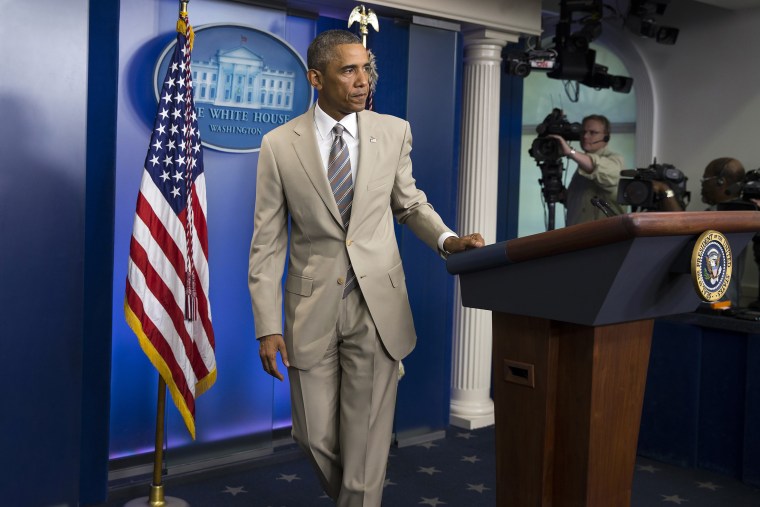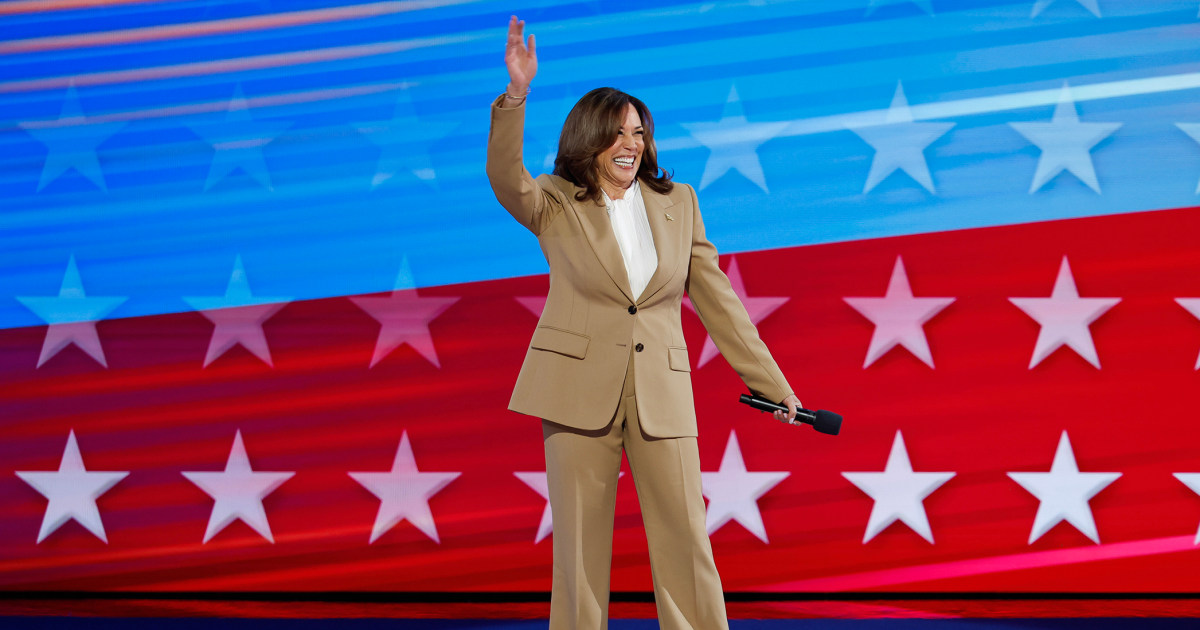Ten years ago, President Barack Obama appeared at a press conference wearing a pale khaki suit and a gray, striped tie. The outfit choice prompted a slew of outraged headlines, particularly from Republicans. Then-New York Congressman Peter T. King contended that the choice was “unpresidential” and that it pointed to Obama’s “lack of seriousness.”
On the first night of the Democratic National Convention, Vice President Kamala Harris stepped onto the stage in a flared-leg tan suit designed by Chloé creative director Chemena Kamali. Harris paired the suit with a cream crepe de chine lavallière blouse, also by Chloé, and high-shine pointed-toe pumps. A similar double-breasted version of Harris’ jacket is available on Chloé’s website. The color listed below its steep price tag is fittingly and, given the tenor of the Harris’ campaign, unsurprisingly called coconut brown.
While the Harris-Walz campaign is quick to embrace all Obama-era commentary and has proven its internet fluency, this fashion moment was Harris’ alone.
The internet was quick to draw parallels between the two outfits. Many X users posited that Harris was deliberately evoking Obama’s tan suit, subtly trolling Republican pundits. Responses to a post made by MSNBC’s “The Weekend” Executive Producer Kyle Griffin included “troll game strong” and “I yelled and then had to explain to my kid why the tan suit was an expert level choice for her.”
While the Harris-Walz campaign is quick to embrace all Obama-era commentary and has proven its internet fluency, this fashion moment was Harris’ alone.
Harris’ campaign outfits are a sign of a new era of political dressing. Her campaign wardrobe, from the now iconic Chloé suit to her brightly colored tailored separates with pared down Chucks, is not representative of the bygone 2010s “Lean In” girlboss dressing or 1980s suiting as a means to battle in-office sexism. No, Harris’ outfits exist wholly in the context of today.
The year 1992, dubbed “the year of the woman” for electing four women to the Senate, led to a significant moment for women’s suiting. The following year, then-Maryland Sen. Barbara Mikulski became the first woman to wear a pantsuit on the Senate floor when she and then-Kansas Sen. Nancy Kassebaum launched a subdued but effective protest: They wore pants and told female staffers to do the same. In the years after, the pantsuit became the accepted and almost compulsory apparel for women in Washington, including for Hillary Clinton.

Donning pants instead of skirts is historically revolutionary. Selecting clothing that exists outside of what is attractive to a patriarchal society is a weapon that women have used to protect themselves for generations, as a means to demand respect and safety. A contemporary, more grim, version of this can be seen in a viral TikTok trend showing young women covering their fashionable miniskirts with baggy t-shirts on the New York subway.
Being a woman on public transportation, on Capitol Hill, in court rooms, on Wall Street and in newsrooms has until very recently been viewed a detriment. And while clothing, of course, neither protects you nor precludes you from sexual harassment or assault, the way you dress is a vehicle for respect, power and self-confidence. In the aftermath of #MeToo, standing on the shoulders of women trailblazers, traditionally male silhouettes are no longer required. Today, two things exist at once: womanhood and power.
Harris’ Chloé suit set the tone for the rest of DNC and for the rest of her campaign. In wearing her suits and not, say, a more conventional navy, knee-length skirt, Harris is signaling that she is unafraid to carve her own path forward. (As the first Black and Indian American woman on the ticket, this is impossible anyway.) In this way, this suit — a modern spin on traditionally accepted political women’s wear — mirrors her candidacy. Harris is demanding respect in her own way. Perhaps the most radical and revolutionary of all: Harris looks pretty. She looks presidential.
Suits, although awash on the DNC stage, have little practical space in a contemporary woman’s wardrobe, except as subversive. It is chic and popular, in perpetuity, to wear a deconstructed suit to a formal event à la Bianca Jagger’s seminal Yves Saint Laurent wedding outfit. With more employees working from home, very few workplaces require the sort of formality that Washington still does. The suit has mostly been replaced with so-called power dressing: shoulder pads, oversized blazers, slouchy boyfriend-without-the-boyfriend jeans. Clothing that skews more gender neutral is not just trendy, but it is also mainstream.
Once again, Harris has proved incredibly adroit at reading and tapping into the zeitgeist. Chloé and boho chic are experiencing a resurgence. A few weeks ago, Sydney Sweeney wore head-to-toe Chloé in black thigh-high leather boots, a cream-colored mini dress and capelet. Daisy Edgar-Jones spent much of her “Twisters” press tour in Chloé, including a stunning sky blue, sheer ruffled maxi dress. And Harris, having publicly worn the French brand at least three times, is now listed in their ranks.
In 2008, one of the campaign slogans Obama ran on was “change we can believe.” Then, Americans were craving something different, something outside the beltway. His tan colored suit signaled that he was going to do things his way. It signaled that he was that change. Ten years later, Americans still want change they can believe in. Despite her policies, her record, her personal beliefs, Harris, as a powerful Black and Indian woman, will never be inside the beltway. Indeed, Harris’ fashion choices will be picked apart and analyzed in ways Barack Obama could never even fathom. She may as well wear a tan suit.

Leave a Reply